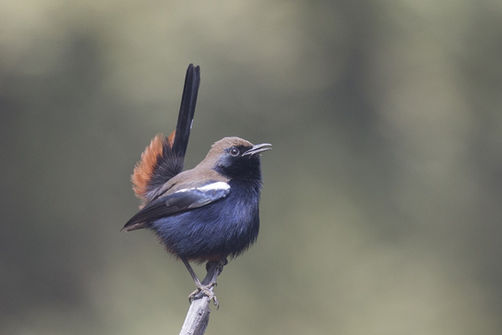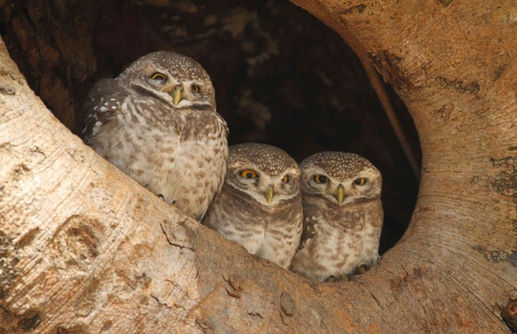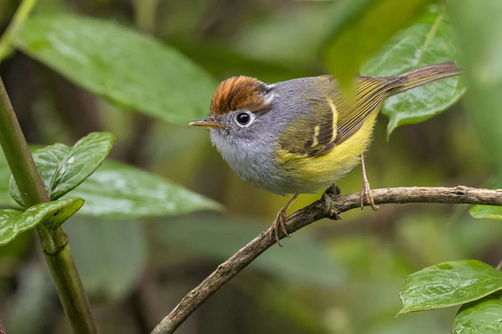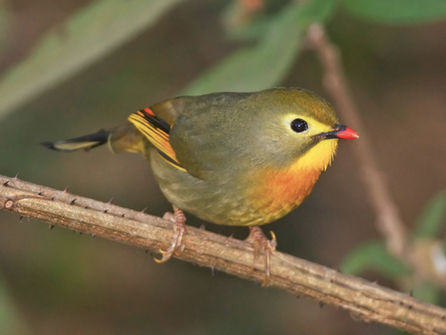Northern India: Birding with a Camera (BwC)
Tour Overview:
Everyone knows that India is mystical; a land of striking contrasts with a fabulously rich heritage, welcoming people, and delicious food. India also offers an intoxicating mixture of awesome birds, haunting vistas, mist-cloaked herds of deer, and the entrancing Tiger. Due to religious teachings extolling kindness towards nature, it also offers some of the tamest birds and mammals on Earth and some of the easiest photography as a result. This is an ideal blend to keep birders who love photography really happy. You will come away having seen several hundred species, with gigabytes of images of many of them.
Tour Details:
2027
Main Tour: 23 January - 6 February
TBA (2026 price was $6680; single supplement: $850)
Extension: 7 - 12 February
TBA (2026 price was $2600; single supplement: $580)
Length: 15 Days (21 Days w/ Extension)
Starting City: Delhi
Ending City: Delhi
Pace: Moderate
Physical Difficulty: Easy/Moderate
Focus: Birding, Wildlife, Photography, Culture
Group size: 9 + 1 Leader
Ready to Book?

Detailed Itinerary
Day 1: Delhi
After arrival we’ll enjoy some birding and the sights of Old Delhi. We stay the first night in the city.
Day 2: Delhi to Naini Tal
From Delhi we drive to Gajraula, a small town close to the Ganges River. In the afternoon we visit a bridge over this sacred river to look for Pallas's Gull, River Tern, and the highly-localized White-tailed Stonechat. Later we drive to Naini Tal, leaving behind the Indian plains and climbing up through the Himalayan foothills. We spend the next four nights at a quaint colonial retreat in the mountains.
Days 3-5: Naini Tal
An attractive reminder of the British Raj era, this hill station is at an elevation of 6,600 ft. (2,000 m.). Surrounding peaks tower above, and on clear days there are spectacular views of snowy Himalayan giants that lie less than 50 mi. (80 km.) away. Bearded Vultures and Himalayan Griffons soar majestically overhead while we bird a mixture of open country and forest patches for fantastic birds like Great Barbet, Speckled Piculet, Black-headed Jay, Red-billed Blue Magpie, Gray Treepie, and Rusty-cheeked Scimitar-Babbler. Working the Sat Tal area and the Mongoli valley should reveal an assortment of six laughingthrushes, Rufous Sibia, Himalayan Rubythroat, Spotted Forktail, and flocks of tits, nuthatches, and treecreepers. The area also has several feeding stations that offer great photo ops and chances to see rarer species. We will also spend time at higher altitudes, and with luck we ought to find some mega birds such as Altai Accentor, Koklass Pheasant, Rufous-bellied Woodpecker, and Pink-browed Rosefinch.
Day 6: Naini Tal to Kumeria
This morning we make our way to the edge of the famed Corbett NP, founded by the early conservationist Jim Corbett. We will overnight just outside the park at Kumeria, with lush grounds and photographable birds in the backyard.
Day 7: Corbett NP
Corbett is a top birding area and the mixed-species flocks are superb. The tracks around here may reveal Kalij Pheasant, Chestnut-headed Tesia, or Immaculate Wren-Babbler. We will need to be opportunistic with the cameras as the mixed-species bird flocks pass through quickly. Mammals like Sambar, Asian Elephant, and Rhesus Macaques, are much more cooperative. We even have a chance to see Tiger, though it’s much more difficult here than on the extension. We will spend the night at the simple Dhikala Camp within the park.
Day 8: Corbett NP and Kumeria
The rushing Kosi River near our Kumeria resort holds Little Forktail, Brown Dipper, Crested Kingfisher, and the spectacular Wallcreeper and scarce Ibisbill. If any of these megas are located, we will spend a little time trying to get keeper shots of them. We’ll spend one more night in Kumeria.
Day 9: Kumeria to Delhi
After a last morning in the Himalayan foothills we return to Delhi for another night.
Day 10: Delhi to Bharatpur
On the journey to Bharatpur, we traverse the heartland of Hindu India. Rural scenes of huts, mango groves, and mustard fields are interspersed with urban areas where cows hold sacred sway next to lines of cycle rickshaws and noisy trucks. We stay the next three nights in Bharatpur.
Days 11-12: Bharatpur area
Bharatpur was formerly a hunting reserve for the Maharajas (Hindu royalty). In years of good rainfall, productive marshes, bushy savanna, and acacia thickets sprawl to the horizon. Bharatpur supports an incredible diversity of waterbirds including Oriental Darter, Painted Stork, and Asian Openbill. The shallow food-rich lakes support stalking Pheasant-tailed and Bronze-winged Jacanas, while Black-necked Storks and stately Sarus Cranes work the edges. Waterfowl abound, and we often see Bar-headed Goose, Lesser Whistling-Duck, Cotton Pygmy-Goose, and the odd Knob-billed Duck. In the woodlands, we could encounter Gray Francolin, Yellow-footed Green-Pigeon, Indian Gray Hornbill, and Black-rumped Flameback. Bharatpur is home to many raptors, and the skies are rarely devoid of birds of prey. Opportunities for seeing mammals are also excellent, with the huge Blue Bull, Sambar, Wild Boar, Golden Jackal, and others roaming the reserve. Depending on water-levels we will split our time between here and the nearby Bund Baretha. This area will be a boon for photography and we can expect many full memory cards each day.
Day 13: Dholpur
Leaving Bharatpur, we explore the dry reaches of the Dholpur district, hoping for Rufous-fronted Prinia, Variable Wheatear, and many other arid-country species. We enjoy the first of two river cruises on this trip in an area that has become much more reliable for the scarce and declining Indian Skimmer.
Day 14: Dholpur to Agra
We head to Agra to visit the mystical Taj Mahal. The Mogul emperor Shah Jahan built this mausoleum of ethereal beauty in memory of his wife Mumtaz. In the afternoon we head for the Chambal Safari Lodge.
Day 15: Chambal River to Delhi
Early this morning we’ll take a cruise on one of the wide-open stony-bedded tributaries of the mighty Ganges River. This area has several specialty birds including the Great Thick-knee, Sand Lark, and Black-bellied Tern. We should also find the bizarre Gharial and its cousin the Mugger Crocodile. With luck we might even encounter the critically endangered Ganges River Dolphin. Photo opportunities abound on the river. After lunch, those finishing today will head back to Delhi for evening flights, while those joining the Tiger extension jump on the overnight train from Agra to Umaria.
Tiger Extension
Day 1: Arrival
Overnight train from Agra to Umaria. We arrive and drive to our lodge in Bandhavgarh.
Days 2-4: Full days within Bandhavgarh NP
This diverse park boasts 110,000 acres (44,000 ha.) of sal forest, woodland, bamboo, and grassland. The chances of seeing this great feline are better here than anywhere else in the world, though spotting a tiger still takes some luck. The sal also harbors some great birds like White-naped Woodpecker, Sirkeer Malkoha, Greater Racket-tailed Drongo, Indian Scimitar-Babbler, Golden-fronted Leafbird, Malabar Pied-Hornbill, White-eyed Buzzard, and Jungle Bush-Quail. Bandhavgarh is also endowed with several pans and waterholes, which are magnets for mammals in the dry season. Chital, Sambar, Barking Deer, Golden Jackal, Wild Boar, Rhesus Macaque, and Hanuman Langur are all regular. We’d need more luck to see Leopard, Indian Wild Dog, Striped Hyena, or Sloth Bear.
Day 5: Bandhavgahr to Delhi
After most of the day in Bandhavgarh NP, we return to Delhi via a domestic flight.
Day 6: Departure
The tour ends this morning in Delhi’s international airport.
Trip Considerations
PACE: Easy to Moderate. Although we don’t have a great deal of “down time” on this tour, the winter days are quite short, and the sun rises at about 7am. We generally sleep close to our birding sites, and don’t have long pre-dawn drives. Most of our meals will be taken in lodges in restaurants, though on a couple of days, we will have a packed lunch.
PHYSICAL DIFFICULTY: Birding will be done on foot throughout this trip, but the walking is mostly easy, either on broad paths or roads. On the tiger extension, most birding will be done from vehicles. Roads are generally good on this tour, but there are a couple of all-day drives, namely to and from the Himalayas on days 2 and 9. The overnight train ride (on the extension only) is very long (over 12 hours), and some people find this tiring, although we will have comfortable sleeping berths. The highest elevations on this tour are about 6500 feet (2000m).
CLIMATE: Ranges from hot and dry on the northern plains to chilly and damp in the Himalayan foothills. Temperatures may drop to below freezing at night around Naini Tal. Although there is not central heating, portable heating units are available in most hotels.
ACCOMMODATION: Generally excellent, with one night in moderate accommodation within Corbett NP, and one night on a sleeper train on the extension. Several nights on this trip will be spent in former Maharaja’s palaces! All hotels have private bathrooms and most have 24h electricity, except on the overnight sleeper train.
EXPECTATIONS: We cover lots of ground and habitats and can expect to see well over 350 species of bird on this trip, and are likely to be able to photograph more than 100 species. There will also be many mammals and other wildlife seen and photographed. And the remarkable culture of India is worthy of a few snaps itself.
GEAR: Binoculars are essential. Your leader will have a scope. Light is quite good in India, and you can get away with using zoom lenses and/or high f-stop lenses. However, using prime 300 f2.8 or 500 f4 lenses (with and without teleconverters) works too. There are also a myriad of opportunities to take landscape photos and also there are some opportunities for cultural photography of temples and/or people. Macro photography and nocturnal photography will be limited as there are only a handful of subjects we target.
Other Information
TRAVEL REQUIREMENTS: A valid passport is required; the passport must be valid for at least six months past your intended stay. A visa is required. It can be applied for online by citizens of the US, UK, and many other countries. The cost of the visa depends on your nationality, and ranges from $0-$60. This eVisa can be applied for only 30 days or less before your trip. It is also possible to apply for a visa through an Indian consulate or embassy. Travel requirements are subject to change.
WHAT’S INCLUDED?: Tips to local guides, drivers, and lodge/restaurant staff; accommodation from the night of day 1 to the night of day 14, and from the night of day 1 to the night of day 5 for the tiger extension; meals from dinner on day 1 (unless you arrive too late for dinner service) to dinner on day 15, and breakfast on day 1 to breakfast on day 6 of the tiger extension; reasonable non-alcoholic beverages during meals; safe drinking water between meals; Tropical Birding tour leader with scope and audio gear from the morning of day 1 to the evening of day 15, and the morning of day 1 to the evening of day 5 on the tiger extension; one arrival and one departure airport transfer per person (transfers may be shared with other participants of the same tour if they arrive at the same time); ground transport for the group to all sites in the itinerary in a suitable vehicle(s) with local driver(s); entrance fees and local guide fees for all the birding sites mentioned in the itinerary; a printed and bound checklist to keep track of your sightings (given to you at the start of the tour – only electronic copies can be provided in advance).
WHAT’S NOT INCLUDED?: Optional tips to the Tropical Birding tour leader; tips for luggage porters (if you require their services); snacks; additional drinks apart from those included; alcoholic beverages; travel insurance; excursions not included in the tour itinerary; extras in hotels such as laundry service, minibar, room service, telephone calls, and personal items; medical fees; other items or services not specifically mentioned as being included.
Tour Reviews
*Participated on this Tour? Leave a Review! We would also love to see your favorite photo, upload it!











